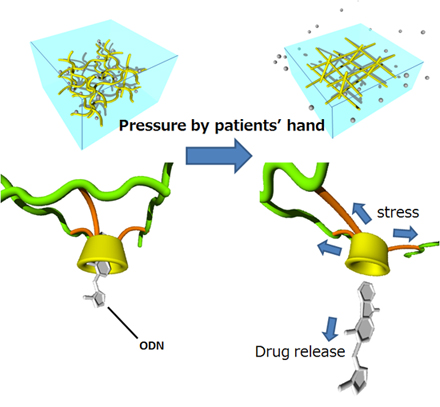Novel Drug Delivery System Releases Drugs in Response to Compression by the Patient’s Hand
Towards a Future-type Drug Administration Method Not Requiring Electricity, Water, or Special Devices
2013.03.01
(2013.03.14 Update)
National Institute for Materials Science
A research group headed by Dr. Katsuhiko Ariga, a MANA Principal Investigator, Dr. Kohsaku Kawakami, a MANA Scientist, and Dr. Hironori Izawa, a MANA Post-Doctoral Researcher (currently Assistant Professor of Tottori University) of the NIMS International Center for Materials Nanoarchitectonics (MANA) succeeded in developing a gel material which is capable of releasing drugs in response to pressure applied by the patient.
Abstract
- A research group headed by Dr. Katsuhiko Ariga, a MANA Principal Investigator, Dr. Kohsaku Kawakami%22" class="verbiage_item OuterLink">Kohsaku Kawakami, a MANA Scientist, and Dr. Hironori Izawa, a MANA Post-Doctoral Researcher (currently Assistant Professor of Tottori University) of the International Center for Materials Nanoarchitectonics (MANA), National Institute for Materials Science (President: Sukekatsu Ushioda) succeeded in developing a gel material which is capable of releasing drugs in response to pressure applied by the patient.
- Drugs are generally taken by oral administration, injection, etc. However, the conventional methods may cause side effects and inconveniences. Although stimuli-responsive drug delivery systems are an effective technique which solves such problems, a special device is necessary in order to apply the stimulus.
- The MANA research group developed a gel material envisioning a new drug administration method in which the drug is released when the patient applies manual pressure to the gel. Using samples of the gel containing the anti-emetic drug ondansetron, the researchers confirmed that the drug was released when stimulus mimicking finger-pressure by the patient was applied, and found that this effect was maintained for at least 3 days. Although oral administration of drugs is difficult for patients experiencing nausea during cancer chemotherapy, if this material is introduced under the skin, it is expected to release the drug simply by pressing or rubbing it.
- Because this material does not require special devices, electricity, etc., it can be used even when lifeline infrastructure has been interrupted by disasters, in developing countries where the lifeline is inherently inadequate, etc. It will also be possible for patients to administer drugs under any environment at their own intention. Many situations where patients wish to administer drugs quickly “on-demand” are also assumed, for example, for relief from cancer pain, hay fever, or asthma. Thus, this material offers an extremely convenient new dosing strategy.
- The gel is produced by crosslinking calcium alginate, which is a naturally-derived component contained in algae, with cyclodextrin, which is a saccharide. Both substances are already used in pharmaceuticals. Cyclodextrin hosts a drug as a guest. This is the first report in which a host-guest interaction is controlled by mechanical stimulus.
- These research results were obtained in the Research Theme “Dynamic Interfacial Nanotechnology for Integration between Nano and Macroscopic Worlds” (Principal Investigator: Katsuhiko Ariga) in the JST-CREST Research Area “Development of high performance nanostructures for process integration” (Research Supervisor: Masahiro Irie).
- These results were published in the online bulletin of the English scientific journal “Journal of Materials Chemistry B”.

Fig. : Conceptual scheme of controlled release of ODN from a hydrogel composed of a CyD-containing molecular network by mechanical compression.
